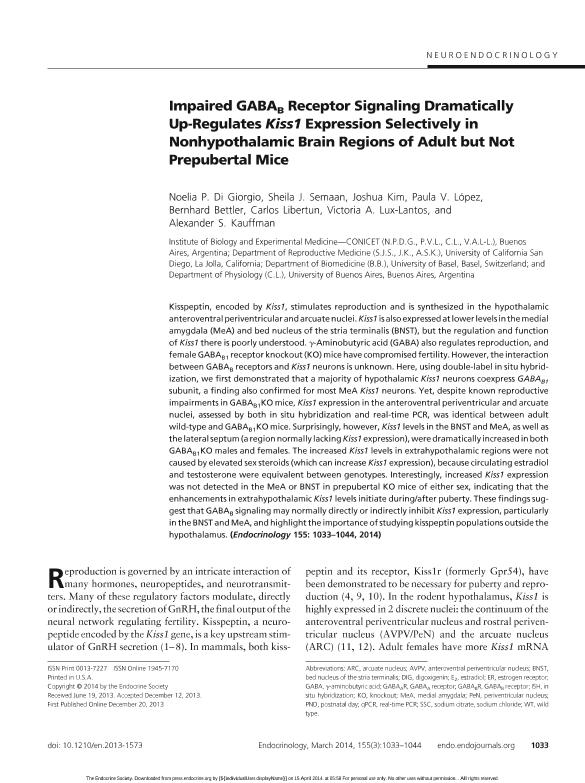Mostrar el registro sencillo del ítem
dc.contributor.author
Di Giorgio, Noelia Paula

dc.contributor.author
Semaan, Sheila J.
dc.contributor.author
Kim, Joshua
dc.contributor.author
Lopez, Paula Veronica

dc.contributor.author
Bettler, Bernhard

dc.contributor.author
Libertun, Carlos

dc.contributor.author
Lux, Victoria Adela R.

dc.contributor.author
Kauffman, Alexander S.
dc.date.available
2017-08-24T16:43:46Z
dc.date.issued
2014-03
dc.identifier.citation
Di Giorgio, Noelia Paula; Semaan, Sheila J.; Kim, Joshua; Lopez, Paula Veronica; Bettler, Bernhard; et al.; Impaired GABAB receptor signaling dramatically up-regulates Kiss1 expression selectively in nonhypothalamic brain regions of adult but not prepubertal mice; Endocrine Society; Endocrinology; 155; 3; 3-2014; 1033-1044
dc.identifier.issn
0013-7227
dc.identifier.uri
http://hdl.handle.net/11336/22929
dc.description.abstract
Kisspeptin, encoded by Kiss1, stimulates reproduction and is synthesized in the hypothalamic anteroventral periventricular and arcuate nuclei. Kiss1 is also expressed at lower levels in the medial amygdala (MeA) and bed nucleus of the stria terminalis (BNST), but the regulation and function of Kiss1 there is poorly understood. γ-Aminobutyric acid (GABA) also regulates reproduction, and female GABAB1 receptor knockout (KO) mice have compromised fertility. However, the interaction between GABAB receptors and Kiss1 neurons is unknown. Here, using double-label in situ hybridization, we first demonstrated that a majority of hypothalamic Kiss1 neurons coexpress GABAB1 subunit, a finding also confirmed for most MeA Kiss1 neurons. Yet, despite known reproductive impairments in GABAB1KO mice, Kiss1 expression in the anteroventral periventricular and arcuate nuclei, assessed by both in situ hybridization and real-time PCR, was identical between adult wild-type and GABAB1KO mice. Surprisingly, however, Kiss1 levels in the BNST and MeA, as well as the lateral septum (a region normally lacking Kiss1 expression), were dramatically increased in both GABAB1KO males and females. The increased Kiss1 levels in extrahypothalamic regions were not caused by elevated sex steroids (which can increase Kiss1 expression), because circulating estradiol and testosterone were equivalent between genotypes. Interestingly, increased Kiss1 expression was not detected in the MeA or BNST in prepubertal KO mice of either sex, indicating that the enhancements in extrahypothalamic Kiss1 levels initiate during/after puberty. These findings suggest that GABAB signaling may normally directly or indirectly inhibit Kiss1 expression, particularly in the BNST and MeA, and highlight the importance of studying kisspeptin populations outside the hypothalamus.
dc.format
application/pdf
dc.language.iso
eng
dc.publisher
Endocrine Society

dc.rights
info:eu-repo/semantics/openAccess
dc.rights.uri
https://creativecommons.org/licenses/by-nc-nd/2.5/ar/
dc.subject
Gabab
dc.subject
Kiss1
dc.subject
Signaling
dc.subject
Brain
dc.subject.classification
Bioquímica y Biología Molecular

dc.subject.classification
Medicina Básica

dc.subject.classification
CIENCIAS MÉDICAS Y DE LA SALUD

dc.title
Impaired GABAB receptor signaling dramatically up-regulates Kiss1 expression selectively in nonhypothalamic brain regions of adult but not prepubertal mice
dc.type
info:eu-repo/semantics/article
dc.type
info:ar-repo/semantics/artículo
dc.type
info:eu-repo/semantics/publishedVersion
dc.date.updated
2017-08-08T14:23:31Z
dc.identifier.eissn
1945-7170
dc.journal.volume
155
dc.journal.number
3
dc.journal.pagination
1033-1044
dc.journal.pais
Estados Unidos

dc.journal.ciudad
Bethesda
dc.description.fil
Fil: Di Giorgio, Noelia Paula. Consejo Nacional de Investigaciones Científicas y Técnicas. Instituto de Biología y Medicina Experimental. Fundación de Instituto de Biología y Medicina Experimental. Instituto de Biología y Medicina Experimental; Argentina
dc.description.fil
Fil: Semaan, Sheila J.. University of California at San Diego; Estados Unidos
dc.description.fil
Fil: Kim, Joshua. University of California at San Diego; Estados Unidos
dc.description.fil
Fil: Lopez, Paula Veronica. Consejo Nacional de Investigaciones Científicas y Técnicas. Instituto de Biología y Medicina Experimental. Fundación de Instituto de Biología y Medicina Experimental. Instituto de Biología y Medicina Experimental; Argentina
dc.description.fil
Fil: Bettler, Bernhard. Universidad de Basilea; Suiza
dc.description.fil
Fil: Libertun, Carlos. Universidad de Buenos Aires. Facultad de Medicina; Argentina. Consejo Nacional de Investigaciones Científicas y Técnicas. Instituto de Biología y Medicina Experimental. Fundación de Instituto de Biología y Medicina Experimental. Instituto de Biología y Medicina Experimental; Argentina
dc.description.fil
Fil: Lux, Victoria Adela R.. Consejo Nacional de Investigaciones Científicas y Técnicas. Instituto de Biología y Medicina Experimental. Fundación de Instituto de Biología y Medicina Experimental. Instituto de Biología y Medicina Experimental; Argentina
dc.description.fil
Fil: Kauffman, Alexander S.. University of California at San Diego; Estados Unidos
dc.journal.title
Endocrinology

dc.relation.alternativeid
info:eu-repo/semantics/altIdentifier/url/https://academic.oup.com/endo/article-lookup/doi/10.1210/en.2013-1573
dc.relation.alternativeid
info:eu-repo/semantics/altIdentifier/doi/http://dx.doi.org/10.1210/en.2013-1573
dc.relation.alternativeid
info:eu-repo/semantics/altIdentifier/url/https://www.ncbi.nlm.nih.gov/pmc/articles/PMC3929734/
Archivos asociados
